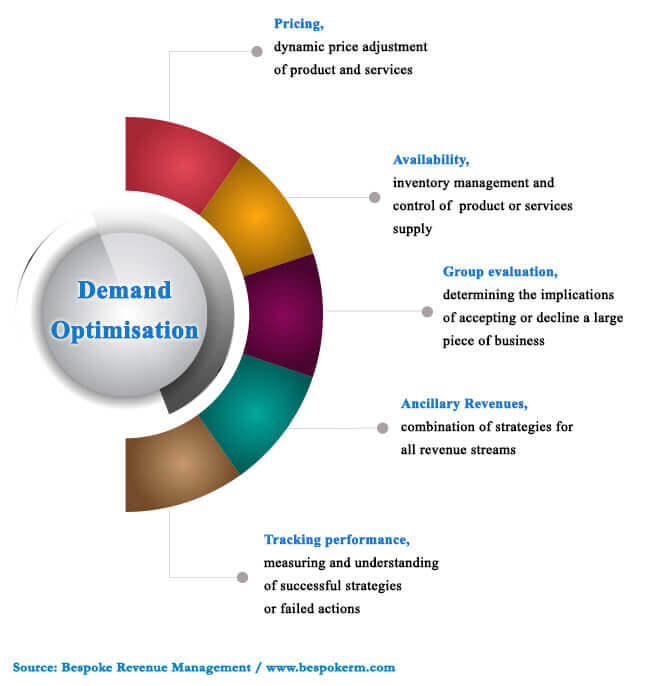In this series of articles on Total Revenue Management (TRM) we started by identifying five core elements namely, Revenue Culture, Market segmentation, Seamless technology, Forecasting by Revenue stream and Optimisation by Revenue stream, that consist the fundamentals for efficiently and effectively embracing such a business practice.
NB: This is an article from Bespoke RM
While the first three pave the way for successfully adopting and implementing TRM as a commercial philosophy, the last two involve the day-to-day ongoing operational activities for managing revenues and profits. This article will focus on Optimisation as a necessary tool for a successful total revenue management plan.
What is Optimisation?
Optimisation, a cornerstone of Revenue Management operations, is the action of making the best or most effective use of a hotel’s inventory while guiding the simultaneous action of revenue and profit growth. It ensures the best and most effective use of strategies and tactics in order to balance supply and demand and deliver the optimal business mix. Optimisation relies on intelligence gathered during forecasting, a process that indicates changes or variations in booking pace of a segment or segments, in order to deliver an updated action plan. It then moves on to investigate external factors that influence demand providing thus with a complete view and understanding of all dynamics.
Optimisation drives the ongoing process of controlling product availability and price to ensure revenue and profit growth. In a constantly changing market place, having a thorough understanding of booking patterns, lead times and cost of distribution will enable managing demand not only by price but also by cost of acquisition & contribution by revenue stream or centre.
With demand fluctuating, optimisation aims to highlight deviations from the strategies in place and suggests corrective measures. It takes into consideration the profit elements that influence performance in all revenue streams in order to decide potential reformulation of adopted strategies. Having the right revenue culture makes optimization easier to implement as there will be times where a sacrifice in price will need to be made for a product in one department in order to secure a piece of business that has significant profit value in another.
Fundamentals of the Optimisation process
There are five major elements in the Optimisation process: Pricing, dynamic price adjustment of product and services; Availability, management of inventory and product or services supply; Group evaluation, determining the implications of accepting a large piece of business; Ancillary Revenues, combination of strategies for all revenue streams; Tracking performance, measuring and understanding of successful strategies or failed actions.

#1: Pricing
A coherent pricing strategy starts with the knowledge of your market segments as the process of constructing them has already taken into account the buying power and spending willingness of each, booking patterns along with the cost of acquisition for each segment. This provides a detailed view and understanding of who the customers are, when they book and via what channels and last but not least support the calculation of the profitability of each segment through a better understanding of net rates.
When applying pricing, consideration needs to be given to the impact it has to each of the market segments and how that influence booking behaviour and patterns. A successful pricing approach will determine key decisions on strategies to adopt for revenue maximisation throughout the organisation, while the ability to anticipate demand patterns and preference requirements will facilitate the design and availability of services and products.
Pricing strategies are a consideration of how the business is currently trading in combination with the targets that need to be achieved. Moreover, knowledge of the market and the forces that drive competition is necessary as pricing decisions should not only be based upon what is happening in the hotel, but need to include external factors that influence demand. When it comes to pricing an often misunderstood concept is the notion of dynamic pricing being valuable only when demand is high. Pricing should also be used to stipulate demand as successful marketing activities that target the right segment at its optimal booking window can help create the required “base” business. The amount of required “base” business will vary according to the period of the year and despite popular believe it doesn’t necessary need to be built out of public discount or promotional rates but also from segments such as Groups (leisure and business), Wholesale etc., that have longer booking window.
Finally, it is important to keep in mind the perceived value for money and have a thorough view of the value the market places on the product or service. To achieve this, it is essential to incorporate ranking and review scores from different sources as it can be a critical decision factor for potential customers. To proactively RM your hotel not only by price point but also by cost of acquisition & contribution by revenue source, it is essential to understand the unconstrained market demand. That can be achieved via a detailed forecast which allows the view of how business is likely to perform in the future and it determines the fine-tuning of long term strategies and the deployment of short term tactics.
#2: Availability
As we already discussed, to increase the benefits from a TRM system, it is vital to optimise the buying process and measure total spend while considering different type of customers, their purchasing power, needs and habits.
Availability focuses in optimising and controlling inventory with the purpose of achieving the optimum business mix. By optimum business mix we mean the number of rooms allocated for each market segment, for a specific period, that lead to the best possible revenue and profit though-out the hotel. Moreover, these controls need to be implemented in food and beverage outlets, meeting rooms, spa facilities and any other revenue generating stream. A thorough understanding of profitability by segment and booking channel is imperative for successfully implementing availability controls. The purpose of such controls is to ensure enough inventory is available to the segments that are willing to pay the most when demand is high – traditionally these segments tend to have short lead times.
Some of the most common availability controls for rooms or meeting space are: Minimum Length of Stay (MLOS), requires booking to be made to a minimum predefined number of nights and is used to avoid uneven occupancy patterns that can block longer stays or restrict availability during high demand; Maximum Length of Stay (MaxLOS), requires booking to be made to a maximum predefined number of nights and is used to control discounted or promotional rates; Closed to Arrival (CTA), prevents bookings to be made with arrival on a specific day, CTA is used to avoid blocking days with weaker booking demand. Other controls can include allocating a specific number of rooms to promotional and discounted rates, limiting bookings for specific room types for particular rates etc. Above controls should be applied to all functions and not only rooms. For example, the use of such controls to meeting rooms is of particular interest due to lower fixed costs that can lead to higher returns and profits.
#3: Group Evaluation
Looking at business displacement plays an important part in the optimisation process when deciding which pieces of business to consider or decline. The process of calculating displacement will need to include cost of sale, overall revenue contribution, contribution margins for different revenue centres, past performance over considered dates as well as forecast for the booking period.
Displacement analysis is usually required when considering groups, a large number of rooms booking together, or when coming across requests for extended stays. Every piece of business we accept limits the possibility for other business to book. It is therefore important to understand the impact every decision has and how essential displacement is in planning and driving revenues and profit. While there is a tendency to judge such bids only by rate, special consideration needs to be given in factors such as Total spend in all outlets and the value of the bookings the hotel will not be able to accept in the future. As Groups tend to have a long lead time, the necessary availability controls will need to be implemented in order to allow reaching the target for the optimal mix.
#4: Ancillary Revenues
Ancillary revenues are an often over-looked area for revenue increase. With growing competition and over supply limiting or making achieving significant growth in room sales more challenging, ancillary revenues represent an opportunity for growth from streams that have not traditionally being the focus of attention but can nevertheless provide with significant returns. This has made the effort of maximising all revenue streams to their fullest potential an important factor in the operational process.
Ancillary revenues can be generated throughout the entire customer journey, from placing a booking to checking-in, from throughout the duration of their stay to keeping in contact after the have left the hotel. During the booking process and before arrival, hotels have the opportunity to assist the planning process by providing additional services, options to upgrade to higher room types, promote traditionally no busy periods for dinner, spa or other facilities. During the stay every point of contact becomes an opportunity to sell or upsell. From a room upsell during check-in and in-room amenities to all services offered. After the guest has left asking for feedback becomes the starting point for increasing communication and loyalty.
Beyond generating additional income, optimisation of ancillary revenue streams should aim to combine booking and transactional data. The insights from this analysis will lead to providing customised promotions, offers and service.
#5: Tracking Performance
Tracking and measuring the performance of the optimisation process is a crucial function with countless benefits. The intent of this practice is to take a thorough look into strategy and procedure execution and offer clues on how to enhance their future performance. Combining and analysing the information gathered through the deployment of various strategies and the insights gained through examining their outcome, booking history and trend data will allow you to make better and more informed decisions that will prove to be advantageous for your hotel business overall. Furthermore, it can provide insights in underlying inadequacies in strategy setting which can lead to more efficient ways to utilise marketing and sales resources. Identifying areas of improvement will can lead to more precise results by improved methodologies and capacity utilisation, increased return on investment by enhanced promotional efficiency and better customer satisfaction.
Although a considerable amount of time is spent in drawing and deploying strategies, not enough effort is put into trying to understand if these reached their intended target or what can be done to improve future performance. Tracking and measuring the impact of the process can increase the effectiveness of demand optimisation and lead to more accurate and operationally valid actions.
Even though the components emphasised in this series of articles are by no means a definitive list for a TRM system they highlight some key focus areas. And while there are still challenges in the adoption of such a business practice it is an exciting time for Revenue management. Technological advances have led to systems with enormous potential for handling the complexities of managing revenue streams due to their abilities in advanced problem solving, reasoning and perception. This will elevate the role of RM and empower it to reach its full potential whilst allowing the whole organisation to benefit from its concepts.




